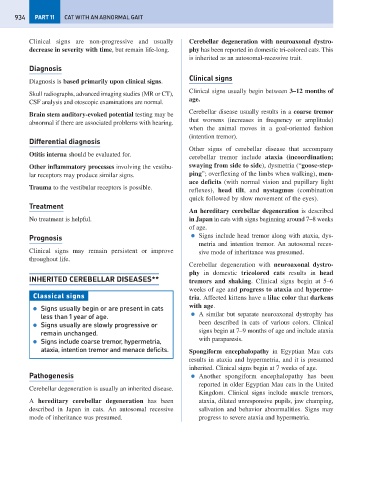Page 942 - Problem-Based Feline Medicine
P. 942
934 PART 11 CAT WITH AN ABNORMAL GAIT
Clinical signs are non-progressive and usually Cerebellar degeneration with neuroaxonal dystro-
decrease in severity with time, but remain life-long. phy has been reported in domestic tri-colored cats. This
is inherited as an autosomal-recessive trait.
Diagnosis
Clinical signs
Diagnosis is based primarily upon clinical signs.
Clinical signs usually begin between 3–12 months of
Skull radiographs, advanced imaging studies (MR or CT),
age.
CSF analysis and otoscopic examinations are normal.
Cerebellar disease usually results in a coarse tremor
Brain stem auditory-evoked potential testing may be
that worsens (increases in frequency or amplitude)
abnormal if there are associated problems with hearing.
when the animal moves in a goal-oriented fashion
(intention tremor).
Differential diagnosis
Other signs of cerebellar disease that accompany
Otitis interna should be evaluated for.
cerebellar tremor include ataxia (incoordination;
Other inflammatory processes involving the vestibu- swaying from side to side), dysmetria (“goose-step-
lar receptors may produce similar signs. ping”; overflexing of the limbs when walking), men-
ace deficits (with normal vision and pupillary light
Trauma to the vestibular receptors is possible.
reflexes), head tilt, and nystagmus (combination
quick followed by slow movement of the eyes).
Treatment
An hereditary cerebellar degeneration is described
No treatment is helpful. in Japan in cats with signs beginning around 7–8 weeks
of age.
Prognosis ● Signs include head tremor along with ataxia, dys-
metria and intention tremor. An autosomal reces-
Clinical signs may remain persistent or improve sive mode of inheritance was presumed.
throughout life.
Cerebellar degeneration with neuroaxonal dystro-
phy in domestic tricolored cats results in head
INHERITED CEREBELLAR DISEASES** tremors and shaking. Clinical signs begin at 5–6
weeks of age and progress to ataxia and hyperme-
Classical signs tria. Affected kittens have a lilac color that darkens
● Signs usually begin or are present in cats with age.
less than 1 year of age. ● A similar but separate neuroaxonal dystrophy has
● Signs usually are slowly progressive or been described in cats of various colors. Clinical
remain unchanged. signs begin at 7–9 months of age and include ataxia
● Signs include coarse tremor, hypermetria, with paraparesis.
ataxia, intention tremor and menace deficits. Spongiform encephalopathy in Egyptian Mau cats
results in ataxia and hypermetria, and it is presumed
inherited. Clinical signs begin at 7 weeks of age.
Pathogenesis ● Another spongiform encephalopathy has been
reported in older Egyptian Mau cats in the United
Cerebellar degeneration is usually an inherited disease.
Kingdom. Clinical signs include muscle tremors,
A hereditary cerebellar degeneration has been ataxia, dilated unresponsive pupils, jaw champing,
described in Japan in cats. An autosomal recessive salivation and behavior abnormalities. Signs may
mode of inheritance was presumed. progress to severe ataxia and hypermetria.

